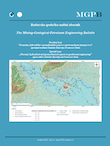A method to evaluate the impact of urbanization on ground temperature evolution at regional scale
DOI:
https://doi.org/10.17794/rgn.2018.5.1Abstract
The replacement of natural soil and vegetation by artificial surfaces increases temperatures of the surrounding air and subsurface throughout the year, because of indirect solar heating of urban structures, building heat losses and land use change. This phenomenon is called Urban Heat Island and it can be better perceived during night-time, when the city releases the heat accumulated during the day. During day-time, due to relatively small amounts of solar radiation received by urban surface, especially in high-density cities in arid and semi-arid climates, Urban Cool Island can be identified as well. The present work illustrates a mixed probabilistic-deterministic method to estimate ground temperature at shallow depth, starting from information on geology, hydrogeology, climate, but also urban presence, through correlations with global land cover and population density. A dedicated mapping on regular grid has been produced. Results have been compared with ground and aquifer temperature available in the literature, for some representative cities of Italian Peninsula and Alpine Zone. Preliminary validations are encouraging and can be taken as a starting point for more comprehensive mapping of ground temperature evolution at regional scale.
Downloads
Published
How to Cite
Issue
Section
License
Copyright (c) 2018 authors and journal

This work is licensed under a Creative Commons Attribution 4.0 International License.
Creative Commons-BY
Authors who publish with this journal agree to the following terms:
In agreeing this form, you certify that:
- You read the ethical codex of the RGN zbornik available at journal web.
- You submitted work is your original work, and has not previously been published and does not include any form of plagiarism.
- You own copyright in the submitted work, and are therefore permitted to assign the licence to publish to RGN zbornik.
- Your submitted work contains no violation of any existing copyright or other third party right or any material of an obscene, libellous or otherwise unlawful nature.
- You have obtained permission for and acknowledged the source of any illustrations, diagrams or other material included in the work of which you are not the copyright owner.
- You have taken due care to ensure the accuracy of the work, and that, to the best of your knowledge, there are no false statements made within it.
- All co-authors of this submitted work are aware of, and in agreement with, the terms of this licence and that the submitted manuscript has been approved by these authors.
Publication licence
You retain copyright in your submitted work, according to journal license policy (CC-BY). By signing this form you agree that RGN zbornik may publish it under the publication licence. In summary the licence allows the following:
Anyone is free:
- To copy, distribute, display, and perform the work.
- To make derivative works.
Under the following conditions:
- The original author must always be given credit.
- The work may not be used for commercial purposes.
- If the work is altered, transformed, or built upon, the resulting work may only be distributed under a licence identical to this one.
Exceptions to the licence
In addition to publishing the work printed under the above licence, RGN zbornik will also enable the work to be visible online.
The journal editorial can change the licence rules anytime but it cannot retroactively restrict author(s) rights.


